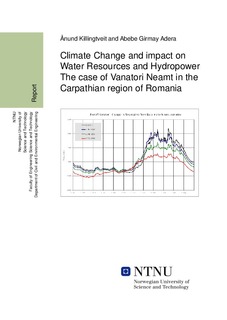| dc.description.abstract | The project “Intelligene Energy Systems in Protected Areas” was initiated by the Technical University of Iasi (TUIASI) with two Norwegian partners, SINTEF Energy Research and Norwegian University of Science and Technology (NTNU). Additional Romanian partners are the Polytechnic University of Timișoara, the Polytechnic University of Bucharest and the Siret Water Basin Administration. Project funded through the RO06 Renewable Energy Programme developed by EEA Grants 2009-2014.
After careful investigations there has been identified as location for the implementation of the research activities in the Natural Park Vanatori Neamt.
This report is from a study of climate change and its impact on water resources and hydropower potential in the area. This was studied by analyzing climate change data from the Euro CORDEX project in combination with a precipitation-runoff model and a hydropower simulation model.
It was possible to see a clear trend in temperature, increasing nearly linearly up to +1.7 0C up to the end of the century for RCP4.5 and by 3.5 0C for RCP8.5. The change in precipitation was less clear than for temperature, with small changes and no consistent trend. From this study, we found seasonal changes in both emission scenarios (Rcp4.5 and Rcp8.5). In general, from January to April both rcp4.5 and rcp8.5 predicts increased precipitation (1% to +20%), and similarly during October – December the precipitation increases from +1% to +12%. However, during the rainy periods (May – September) there is decreased precipitation (-12% to -3%). In summary, for the lowest emission scenario, RCP4.5, there were almost no changes, a decrease of about 1%. For the higher emission scenario, there was a small reduction of 4% for the last 25 years (2075-2099) and +/1 1% before this.
Climate change impacts on hydrology was analyzed by using a HBV Precipitation-Runoff model to convert climate data into time-series of runoff. We found small changes in runoff before 2040, but from then on there was gradual decrease of 10% by 2065 and 25% by 2099. The decrease in runoff is much larger than decrease in precipitation. This is because the increased temperature will lead to higher evaporation.
The impact on hydropower resources was closely linked to the change in hydrology, and like the runoff it was more or less unchanged up to 2040. From here, a gradual reduction was found at 6% by 2065 and 21% by 2099.
The overall conclusion from this study is that it is possible find data and models for doing this type of analysis in Romania. Further studies are also possible, by using the same data sources and models. The results from different climate models and emission scenarios all point to a gradual decrease in runoff and hydropower generation potential in this area. The changes seem to be small up to 2040, from there we estimate a gradual decrease in the order of 20-25% by the end of the century. | nb_NO |
